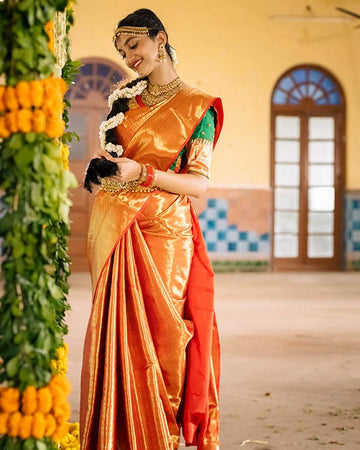Handloom sarees are not just clothes but an art form that exhibits the culture and traditions of India. Some sarees, created with elaborate fine weaving work and fashionable designs, form a part of the profile of Indian heritage that still holds value even today. Of the different handloom sarees, a handloom banarasi saree for wedding is the most famous and every woman’s go-to for any festival or function.
Historical Significance
A traditional handloom saree has been an exclusive part of Indian culture for the past few centuries, with different pockets of India that have sole styles, patterns, and expertise in weaving them. Starting from the fabulous Chanderi sarees Madhya Pradesh to the beautiful Patola sarees of Gujrat, everything about the saree has a historical touch and speaks a lot about its background. This hints at the amazing fact that this practice still exists in India, demonstrating India’s cultural resilience, as well as the commitment of its artisans.
Cultural Identity
Handloom sarees have a centrally embedded place in India’s heritage dress. These are used occasions such as weddings, parties, end-of-the-year celebrations, festivals, and religious functions to signify elegance, culture, and honor to tradition. Every state has its special saree; for instance,Kanjivaram silk sarees is unique to Tamil Nadu, Paithani belongs to Maharashtra, and Katan is specific to Uttar Pradesh. These sarees have gone far beyond mere dress or material wear as they are treated as dowries, long-lasting, and sometimes even inherited and passed down from one generation to another with memories and histories.
The Banarasi Saree: A Wedding Essential
Among all handloom sarees, the most prestigious and often considered suitable for only wedding purposes are the Banarasi sarees. Traditional Banarsi sarees hail from Varanasi, which is famed for its pure silk fabric, rich embroidery, and exquisite brocade work, with zari work done in gold or silver. Banarasi sarees are associated with bridal trousseaus in most cultures in India, representing opulence and heritage as well.
Economic Significance
When it comes to handloom sarees, it is not apparel; it is the confidence, tradition, identity, and creativity of India. They symbolize the cultural oddities or the social patterns, the local and regional cultures, and ergonomics, along with the conservation practices that are integral to the Indian cultural canvas. In the overall consideration of the motif of handloom sarees, they still hold the importance of continuing the conventional tradition of India to the new world.
Modern Relevance and Revival
Even with the increased incorporation of modernity and Western culture in clothing, the handloom saree does not look outdated, and it still has the market. As history suggests, over the last long years, they had become rather obsolete, although, over the recent years, they began to attract more and more attention- due to the trend for purchasing handmade and ecological products. Fashion, especially those made locally, has been rejuvenated through fashion icon promotions through social media and appreciated fashion show suits handloom textile garments. Failure to continue the tradition of wearing and selling these handloom sarees definitely would have been a great loss.
Conclusion
Handloom is one of the biggest employers of millions of artisans all over India, primarily in villages. This sector engages hundreds of weavers, spinners, dyers, and other skilled human resources workers who still depend on handloom techniques. Thus, buying handloom sarees not only supports the livelihood of such artisans involved in the profession but also helps to maintain the traditional practices quietly and steadily. The Indian tradition of buying and flaunting a classic handloom saree with traditional jewelry is part and parcel of India.

